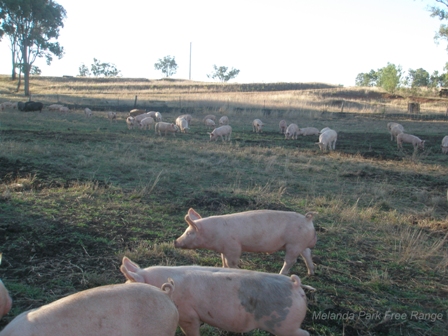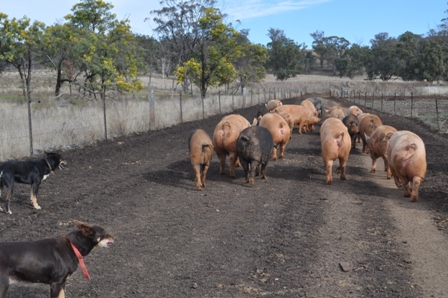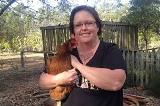| How do I get started in free range pig farming? It’s a question that is now being asked on a regular basis. Firstly, and probably most importantly, contact your local council and ask if there are any restrictions or special requirements for farming pigs in your area. |
| Getting started Firstly, and probably most importantly, contact your local council and ask if there are any restrictions or special requirements for farming pigs in your area. You must have landed that is zoned Rural 1A before you can even contemplate pig farming. Some states require licences and Development Applications. You may also need to have a waste management plan in place. Check before you invest any money into your planned venture as you could be shut down if your piggery is deemed illegal. Buying sows and boars You now have the green light to get started but do not just rush out and buy any old pigs that may be handy in your haste to get up and running. Select your breeding herd carefully as they are the foundation of your business. It’s an expensive lesson to learn if you buy unsuitable sows. Generally, sows that have been bred for the intensive indoor industry will not perform well in a true free range environment. They are selectively bred for traits that suit that industry; in particular, leanness and strong legs that can withstand a lot of time on cement floors. While we will be aiming to produce fairly lean pigs, the lean genes of these commercial type pigs makes it difficult for the sows to keep on condition in an outdoor situation. |  |
| The ideal sows will have been raised free range and proven that they can perform outdoors. Look for an animal that has a nice straight, wide back with nice hams, at least 14 good teats and not too leggy. The sow should have just a nice fat coverage: not too lean and not too fat as neither of these types will perform well. Boars on the other hand, should be purchased from a commercial breeder. They will make all the difference to the pork you produce. Be very careful introducing boars to the outdoors, as it can take several weeks for them to adjust. How many pigs can you run on your farm? The Code of Practice gives us guidelines for space allowances for dry sows and lactating sows with piglets. It suggests 20 – 25 sows per hectare for sows and 9 – 14 hectares for sows with piglets. There are no guidelines for stocking rates for weaners, growers or finisher pigs. The Department of Primary Industries QLD suggests 50m2 for each growing pig up to 30kg. We can only assume the space requirement for larger pigs would be around double that figure. This translates to 200 growers (up to 30kg) per hectare. |
| At first glance these figures would lead you to believe that you could carry a substantial number of pigs on the average 20 acres block ( 9 hectares) but there are many other factors that need to be considered before you decide on the stocking density for your farm. | "Pig stocking densities must be adjusted to suit the land." |
| Choosing a site The choice of an appropriate site for a free range piggery is paramount to both the production efficiency and the welfare of the pigs. Outdoor piggeries, just like any other livestock operation, can impact on the environment if not managed correctly. Ideally, a free range piggery should be sited in an area of less than 800mm of rain per year. Higher, or lower rainfall areas may be acceptable depending on soil type and will require a higher standard of management. Soils should be free draining to prevent plugging and waterlogging. The risk of soil erosion is affected by soil texture, rainfall, slope and ground cover. Poor soil structure will also play a part in soil erosion risk. The risk of flooding must be assessed when siting the piggery on flat land. The potential for soil erosion is one of the main concerns in an outdoor piggery. Stocking densities must be adjusted to suit the land. Steep slopes are generally no suitable because of the higher risk of erosion and runoff. Gentle slopes can be managed by ensuring good paddock rotation and keeping grassed corridors across the slope. This will also ensure access with machinery during wet weather. Ideally, the land would be contoured to slow the movement of water through the property. The maintenance of ground cover is very important for a free range piggery. While grazing a paddock until bare can be an excellent tool when the intention is to crop that paddock, it is most undesirable to over graze paddocks in normal pasture rotations. Ground cover will slow the movement of water, provide additional drainage and help prevent damage to wet soils. Ground cover also acts as an insulator, keeping the ground cooler in hot weather. |
| Grazing You will need to put a paddock rotation system in place to minimize environmental damage. Move pigs on to the next paddock when ground cover is down to approx 40%. Do not graze pigs on that land again until the pasture has recovered. If you are finding that your paddocks are constantly bare (unless the result of drought) you are overstocked. You will experience dust problems and permanent damage to your land. You also risk disease and parasite build up in your herd. In times of drought, pastures should be managed in the same manner and other grazing animals and it is advisable to designate a sacrifice paddock during such times to prevent permanent damage to other areas. All forms of pig production, or any livestock production system, will require sound management skills to ensure the welfare of those animals, the care of the environment and that there is no risk to human health from the pork that is produced. |  |
| Fencing Free range pigs will put your fencing to the test so it will have to be sound. Ringlock 7/30/90 with a standout electric wire works very well. The mesh needs to be very well strained and posts need to be closer together than if you were fencing for sheep or cattle. Feeding Getting pig nutrition right will mean the difference between success and failure of your farm – it is that important. Pigs have the ability to grow at an incredible pace. During the first few months they will lay down mostly muscle and bone and little fat. If you do not have their diet correct you will disrupt that and risk producing pigs that grow too slowly resulting in excess fat, poor muscle development and boar taint. The secret to any successful piggery is to grow your pigs as quickly as possible. The simplest way to ensure adequate nutrition for your pigs is to purchase a ready mixed feed. If you do want to mill and mix your own, consult with an animal nutritionist or purchase a ready made concentrate to mix with your own grain. Selling No matter what state you live in, to sell your pigs you will need to purchase a registered pig brand to identify your animals and ensure traceability. In some states you will also be required to have a Food Safety Program in place that is audited by a third party. Pigs must be accompanied by a National Vendor Declaration (NVD) when they are sold. NVD’s are available from the PigPass website. Each state has different requirements so check with the relevant departments of agriculture. Recent changes have occurred to the legal requirements when selling pigs in NSW. The Prime Fact, Stock Diseases Regulation 2009 - Pigs gives a summary of the important issues that need to be addressed. These new regulations are already in force so you should read and understand your obligations when transporting pigs. Sustainability Free range farmers must become stewards of the land and ensure that pigs do not cause permanent harm to their environment. Pasture management that includes paddock rotations and even spread of manure are vital. Manure built up and run off must be prevented. A carefully planned system can actually be of benefit to the land enabling you to grow crops and grasses fertilized by your pigs. Set stocking of pigs will cause problems not only to the land, but to the health of the herd. Where to from here? For further information on pig farming we recommend you purchase a Pig Farming Starter Kit which contains two popular pig farming books. Both books provide a practical guide to the pig husbandry, including health care, breeding programs for sows and raising piglets. Other articles written by Lee |
 | Lee McCosker - brings not only years of experience in farm animal welfare, but also a wealth of knowledge on free range farm operations, regulatory requirements and animal health and nutrition. After spending the last six years as farm animal welfare consultant to the Humane Society International, Lee's focus is now about a balanced approach to farm accreditation, one that encompasses the farmer, and the animals and nurtures both to ensure the best welfare for the animals but also the best outcomes for the producer and the consumer. www.pastured.com.au |
News Category



